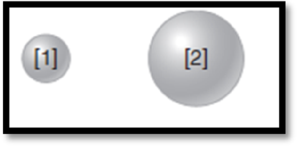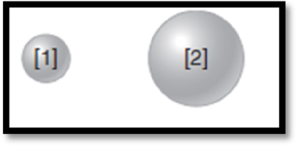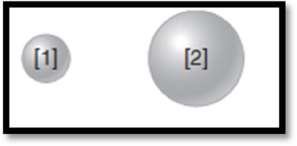
(a)
Interpretation:
The atom has higher
The given diagram is,

Figure 1
Concept Introduction:
Atomic number (Z):
Atomic number of an element is the number of protons found in the nucleus of every atom of that element.
(b)
Interpretation:
The atom has higher ionization energy has to be given.
The given diagram is,

Figure 1
Concept Introduction:
Ionization energy:
Ionization energy is defined as the energy required removing one mole of electron from one mole of isolated gaseous atom or ion.
Periodic trends:
Ionization energy of an element increases along the period and decreases down the group.
(c)
Interpretation:
The atom has higher ionization energy has to be given.
The given diagram is,

Figure 1
Concept Introduction:
Refer to part (a).
Want to see the full answer?
Check out a sample textbook solution
Chapter 2 Solutions
Principles of General, Organic, Biological Chemistry
- 2.42 What is a period in the periodic table? From what does it derive its name?arrow_forward(a) Write out the full electron configuration of Calcium (Ca). (b) How many electrons are in the n=3 shell of Calcium?arrow_forwardBoron, atomic number 5, occurs naturally as two isotopes, 10B and 11B, with natural abundances of 19.9% and 80.1%, respectively. (a) In what ways do the two isotopes differ from each other? Does the electronic configuration of 10B differ from that of 11B? (b) Draw the orbital diagram for an atom of 11B. Which electrons are the valence electrons? (c) Indicate three ways in which the 1s electrons in boron differ from its 2s electrons. (d) Elemental boron reacts with fluorine to form BF3, a gas. Write a balanced chemical equation for the reaction of solid boron with fluorine gas. (e) ΔHf° for BF3(g) is -1135.6 kj/mol. Calculate the standard enthalpy change in the reaction of boron with fluorine. (f) Will the mass percentage of F be the same in 10BF3 and 11BF3? If not, why is that the case?arrow_forward
- Question:Consider two elements, Element A and Element B, from the periodic table. Element A is located in Group 1 and Period 3, while Element B is located in Group 16 and Period 2. (a) Which element would have a larger atomic radius, Element A or Element B? Justify your answer. (b) Predict the ionization energy of Element A and Element B. Which element would have a higher ionization energy? Explain your reasoning. (c) Based on their positions in the periodic table, which element would be more likely to form a stable cation? Provide a brief explanation for your choice.arrow_forwardArrange in order of increasing atomic size. (a) the period 3 elements Cl, Na, and Ar (b) the Group 2A elements Ca, Be, and Mgarrow_forward18. (a) What did Ernest Rutherford observe during his experiments? (b) What did Niels Bohr observe during his experiments? (c) How did the work of each scientist contribute to the development of the planetary model of the atom? Explain your ideas in at least four (4) sentences.arrow_forward
- According to Coulomb’s law, what happens to the potential energy of two oppositely charged particles as they get closer together?(a) Their potential energy decreases.(b) Their potential energy increases.(c) Their potential energy does not change.arrow_forwardWhich of the following statements about the hydrogen atom is FALSE. (A) The hydrogen atom is neutral. (B)The hydrogen atom has a uniform distribution of charge. (C)The hydrogen atom is not polar. (D)The hydrogen atom is spherically symmetric.arrow_forwardThe graph at the right shows the atomic radius for the19 elements in the periodic table.(a) Describe the trend in atomic radius in going fromH (atomic number 1) to K (atomic number 19).(b) Find the three elements represented with blue dotson a periodic table. What do their placements in thetable have in common?(c) Find the three elements represented with red dotson a periodic table. What do their placements in thetable have in common?(d) Based on the graph, what is the radius of C?arrow_forward
- (c) Silicon (Si) is the most common chemical element in today's semiconductor industry. It has an atomic number of 14 and belongs to the Group IV (4) of the periodic table with its most common isotope being Si-29. (i) (ii) (iii) Explain what an isotope is. How many protons and how many neutrons are in the nucleus of this Silicon isotope? What is the electron configuration of Si?arrow_forwardBoron, atomic number 5, occurs naturally as two isotopes, 10B and 11B, with natural abundances of 19.9% and 80.1%, respectively.(a) In what ways do the two isotopes differ from each other? Does the electronic configuration of 10B differ from that of 11B? (b) Drawthe orbital diagram for an atom of 11B. Which electrons are the valence electrons? (c) Indicate three ways in which the 1s electrons inboron differ from its 2s electrons. (d) Elemental boron reacts with fluorine to form BF3, a gas. Write a balanced chemical equation forthe reaction of solid boron with fluorine gas. (e) ΔHf° for BF31g2 is -1135.6 kJ>mol. Calculate the standard enthalpy change in thereaction of boron with fluorine. (f) Will the mass percentage of F be the same in 10BF3 and 11BF3? If not, why is that the case?arrow_forwardQ1. This question is about atomic structure. (a) Write the full electron configuration for each of the following species. CH Fe2+ (b) Write an equation, including state symbols, to represent the process that occurs when the third ionisation energy of manganese is measured. (c) State which of the elements magnesium and aluminium has the lower first ionisation energy Explain your answer. (d) A sample of nickel was analysed in a time of flight (TOF) mass spectrometer. The sample was ionised by electron impact ionisation. The spectrum produced showed three peaks with abundances as set out in the table. m/z Abundance /% 58 61.0 60 29.1 61 9.9 Give the symbol, including mass number, of the ion that would reach the detector first in the sample. Calculate the relative atomic mass of the nickel in the sample. Give your answer to one decimal place. Page 2 of 12 Symbol of ion Relative atomic massarrow_forward
 General, Organic, and Biological ChemistryChemistryISBN:9781285853918Author:H. Stephen StokerPublisher:Cengage LearningChemistry: Matter and ChangeChemistryISBN:9780078746376Author:Dinah Zike, Laurel Dingrando, Nicholas Hainen, Cheryl WistromPublisher:Glencoe/McGraw-Hill School Pub Co
General, Organic, and Biological ChemistryChemistryISBN:9781285853918Author:H. Stephen StokerPublisher:Cengage LearningChemistry: Matter and ChangeChemistryISBN:9780078746376Author:Dinah Zike, Laurel Dingrando, Nicholas Hainen, Cheryl WistromPublisher:Glencoe/McGraw-Hill School Pub Co Introductory Chemistry: An Active Learning Approa...ChemistryISBN:9781305079250Author:Mark S. Cracolice, Ed PetersPublisher:Cengage Learning
Introductory Chemistry: An Active Learning Approa...ChemistryISBN:9781305079250Author:Mark S. Cracolice, Ed PetersPublisher:Cengage Learning Living By Chemistry: First Edition TextbookChemistryISBN:9781559539418Author:Angelica StacyPublisher:MAC HIGHER
Living By Chemistry: First Edition TextbookChemistryISBN:9781559539418Author:Angelica StacyPublisher:MAC HIGHER Introduction to General, Organic and BiochemistryChemistryISBN:9781285869759Author:Frederick A. Bettelheim, William H. Brown, Mary K. Campbell, Shawn O. Farrell, Omar TorresPublisher:Cengage Learning
Introduction to General, Organic and BiochemistryChemistryISBN:9781285869759Author:Frederick A. Bettelheim, William H. Brown, Mary K. Campbell, Shawn O. Farrell, Omar TorresPublisher:Cengage Learning Chemistry for Engineering StudentsChemistryISBN:9781337398909Author:Lawrence S. Brown, Tom HolmePublisher:Cengage Learning
Chemistry for Engineering StudentsChemistryISBN:9781337398909Author:Lawrence S. Brown, Tom HolmePublisher:Cengage Learning





